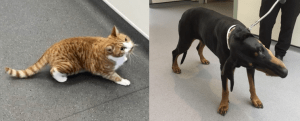Idiopathic Vestibular
Disease
Back to Fact Sheets
Idiopathic vestibular disease is a well-recognised disease of dogs and cats.
Download PDF
What is idiopathic vestibular disease?
Idiopathic vestibular disease is a well-recognised disease of dogs and cats. It is sometimes known as ‘old dog vestibular disease’ or ‘geriatric vestibular disease’, because of its tendency to occur more frequently in older animals.
The vestibular system is responsible for maintaining balance, posture, and the body’s orientation relative to the surroundings. It is comprised of a receptor located in the inner ear which is connected to a nerve; this is known as the ‘peripheral’ vestibular system. The ‘central’ vestibular system is comprised of several collections of cells in the brain. Idiopathic vestibular disease is principally thought to involve the peripheral vestibular system.
What are the clinical signs of idiopathic vestibular disease?
Dogs and cats with idiopathic vestibular disease usually present with a very sudden onset of incoordination, disorientation, a head tilt, falling circling or leaning to one side (usually the same side as the head tilt), and jerking eye movements known as ‘nystagmus’. You might also notice your pet ‘staggering’ or ’walking as if drunk’. Depending on the severity of clinical signs, some animals may be reluctant to or unable to stand or walk. They may also vomit due to nausea associated with incoordination.
How is idiopathic vestibular disease diagnosed?
The term ‘idiopathic’ indicates a disease of spontaneous or unknown origin. Therefore, idiopathic vestibular disease is a diagnosis of exclusion following elimination of other possible conditions. Other common conditions associated with peripheral vestibular disease include:
- Otitis media/ interna (inflammation +/- infection affecting the balance receptors or nerve within the ear)
- Use of drugs which are toxic to the inner ear and cause damage to the balance receptors
- A tumour affecting the receptors or nerve in the ear
MRI (a detailed image acquired with the use of a magnet and radiowaves) or CT imaging (a 3D x-ray) are two diagnostic tests which may be utilised in order to rule out concurrent conditions causing vestibular disease. The advantage of MRI over CT is that it provides detailed information not only on the ears but also on the brain. Additional tests which may be advised include cerebrospinal fluid (CSF) analysis (i.e. analysis of the fluid bathing the brain and spinal), blood pressure evaluation, hormone testing, and urinalysis. These tests can provide a better picture of overall health too, especially in elderly patients.
How is idiopathic vestibular disease treated?
There is no specific treatment for idiopathic vestibular disease and most pets will gradually improve without any specific treatment. Physiotherapy and supportive care are the most important considerations for affected animals. As pets are often very disorientated and unsteady on their feet, it is sensible to restrict them to a pen/crate or small area within the home to prevent accidental injury from a fall. For the same reason affected pets should be prevented from jumping onto furniture or climbing stairs. Affected pets should be provided with soft well-padded bedding to prevent sores if they are lying down for extended periods. Additionally, some pets may need help and supervision while feeding or drinking, or support with a towel or sling when going outdoors to toilet. Cats should not be allowed unsupervised access outdoors while they are demonstrating clinical signs. In dogs or cats which are nauseous and suffer vomiting, anti-sickness treatment can be prescribed by a vet to help with this.
What is the prognosis of idiopathic vestibular disease?
The prognosis for recovery from idiopathic vestibular disease is generally good to excellent. Although pets can be very disorientated which is understandably extremely distressing, most pets will show some signs of improvement within 72 hours. Although full recovery may take 2-5 weeks, some pets may remain with residual deficits such as a head tilt. These residual deficits are generally very mild and do not seem to have any long-term implications for patient quality of life. Some animals may have a relapse of clinical signs in the future; however, this scenario is less common and there is no way to predict this outcome.
If you have any queries or concerns, please do not hesitate to contact us.

Image of a cat and a dog suffering with vestibular disease and demonstrating a characteristic head tilt


